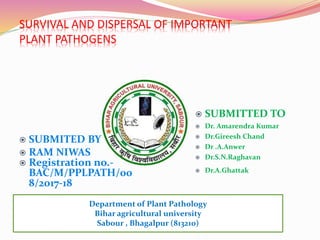
Survival and dispersal of important plant pathogen
- 1. SURVIVAL AND DISPERSAL OF IMPORTANT PLANT PATHOGENS Department of Plant Pathology Bihar agricultural university Sabour , Bhagalpur (813210) SUBMITED BY RAM NIWAS Registration no.- BAC/M/PPLPATH/00 8/2017-18 SUBMITTED TO Dr. Amarendra Kumar Dr.Gireesh Chand Dr .A.Anwer Dr.S.N.Raghavan Dr.A.Ghattak
- 2. INTRODUCTION In the absence of their cultivated host, the pathogens must be find some alternates source of their survival to maintain the infection chain. The means of survival are the first link in the infection chain or the disease cycle. The initial infection that occurs from these sources in the crop are called primary infection and the propagules are called primary inoculum. After initiation of the disease in the crop, the spores or cells or other structures of the pathogen are sources of secondary inoculums and cause secondary infection. The primary infection initiate the disease and secondary infection spread the disease.
- 4. SURVIVAL OF PLANT PATHOGENS 1.Infected host as reservoir of primary inoculum 2.Saprophytic survival of fungal pathogens 3.Dormant organs of fungal pathogens as source of survival and primary inoculum SURVIVAL OF FUNGAL PATHOGEN
- 5. 1. (a)CULTIVATED HOST Eg. Mostly pathogens of fruit trees, plasmopara, pyricularia, drechslera, erysiphe etc. (b)COLLATERAL HOST Eg. Yellow rust pathogen in wheat, bromus spp. And agropyron. (c)ALTERNATES HOST Eg. Stem rust- barberis and thalictrum-leaf rust. INFECTED HOST AS RESERVOIR OF PRIMARY INOCULUM
- 6. In the absence of the living host ,the facultative parasites are capable of surviving as saprophytes. Soil and plant debris serve as media for this saprophytic survival. Spp. Of Pythium, Sclerotium etc. resting structure like oospores and sclerotia .In Pythium aphanidermatum( foot rot of papaya), the fungus rapidly forming oospores. S. rolfsii, Sclerotia are formed and these can germinate under decaying residues. P. aphanidermatum Sclerotia
- 7. DORMANT ORGANS OF FUNGAL PATHOGENS AS SOURCE OF SURVIVAL AND PRIMARY INOCULUM (1)Soil borne fungi:-a.dormant spores(conidia,chlamydospores,oospores,perithesia etc.) b.other dormant structure such as thickened hyphae and sclerotia. (2)Seed borne fungi:-a.dormant spores on seed coat b.dormant mycelium and spores under the seed coat or in the embryo.
- 8. (3)Dormant fungal structures including dead plant parts remaining on the trees. P. brassicae survive through its resting spores lying free or in crop debris in the soil for upto 10 years. S. subterranea survive through spores balls.Pythium ,Phytophthora and albugo are produced dormant structure oospores and conidia Plasmodiophora plant debries Phytophthora on dead plant
- 9. SURVIVAL OF PHYTOPATHOGENIC BACTERIA 2.IN PLANT RESIDUE Eg. Xanthomona s, Ralstonia,Pse udomonas etc. 3.IN SOIL Transient visitors and resident visitors Eg. Erwinia,Clavibacter. ralstonia.serratia etc. Agrobacterium,Streptomys es etc. 4. WITH INSECT Eg. E.trachiphila – D.undecimpunt ata 1.IN SEED Eg.Xanthomon as,clavibacter, pseudomonas etc No resting spores or simillar structures except in such genera as bacillus and clostridium which form resting endospores or in S. scabies which form conidia
- 10. Dormant structure(eggs,cysts,galls,cockles etc.). Quiescence is an adaption for survival of nematodes under adverse conditions. A. tritici are viable for upto 28 years in cockles, G.rostochiensis viable 7-8 years in absence of the host. CYST S GALLS
- 11. SURVIVAL OF PHANEROGAMIC PLANT PARASITES CUSCUTA-DODDER LORANTHUS ORABANCHE-broomrape STRIGA-witch weed
- 12. DISPERSAL OF PLANT PATHOGEN Transport of spores or infectious bodies, acting as inoculum, from one host to another host at various distances resulting in the spread of the disease. OR Displacement of a plant pathogen from its place of production or origin to a suitable place where it can grow/establish.
- 13. SPORE LIBERATION(TAKE OFF) Squirt gun mechanism:-Ascus swells at maturity and brust at the tip in air. Rounding off mechanism:- Top of sporophore rounded off and ejected into air. Mechanical momentum:-Through rain drop and winds. Blowing away:-Rust uredospore. Spash:-Pycnidia.
- 14. SPORE LANDING(DEPOSITION) Sedimentation:-Under the influence of gravity. Impaction:-wind flowing. Rain deposition. Dispersal of plant pathogen are mainly consist of two method viz. active and passive dispersal. Active dispersal:- No need any type of external energy for dispersal of plant pathogen. By soil:-Pythium and phytophthora form zoospores can swim with water in the soil, Actinomycetes, Synchytrium and Fusarium can also grow in the soil.
- 15. By seed:-Cuscuta, sclerotia of ergot fungi, ear cockle and cyst containing nematode. Pathogen present in seed coat such as smut of bajra, karnal bunt of wheat, bunt of rice and leaf smut of rice ,BLB etc. Pstv are transmit by pollen. By plant organ:- Mostly in vegetative propagated plant such as black wart potato, late blight of potato, citrus canker etc.
- 16. Passive dispersal:-This type of dispersal are done by the help of any type of external energy such as animals, insects, and nematode etc. Animals:-Through vegetative propagation such as late blight of potato, bacterial wilt of banana, sigatoka disease of banana etc. Insects:- Cucurbit wilt(E. Trachiephila-spoted cucumber beetle-Diabrotica undecimpunctata), dutch elm disease-Ceratostomella ulmi etc. Nematode:-Yellow ear rot of wheat- Rathayibacter tritici, grape fan leaf-xiphinema, nepo-longidorus, tobra-trichodorus etc.
- 17. Surface running water after heavy rains Long distance ------ floods Ex: The mycelial fragments, spores or sclerotia of fungi,Colletotrichum , Fusarium, Macrophomina,Pythium, Phytophthora, Sclerotium, etc., DISPERSAL BY WIND Short distance dissemination sporangia of downy mildew fungi, conidia of powdery mildew fungi and basidiospores of rust fungi Long distance dessimination Uredospores of rust fungi, Chlamydospores of smut fungi conidia of Alternaria, Helminthosporium and Pyricularia, etc.